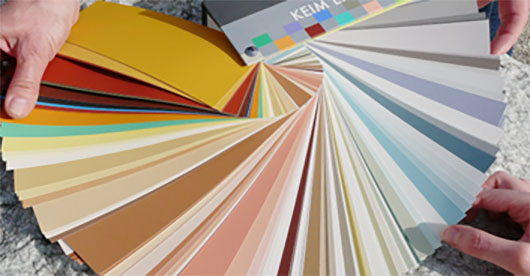Maintenance of KEIM Interior Paint Finishes
Mineral Silicate interior paints and stains are extremely durable but like most paint finishes require routine maintenance to keep them looking their best. The mineral matte flat nature of mineral paints adds to the unique aesthetic and light radiant properties of our paints—and requires a unique approach to cleaning and maintenance.
Regular Cleaning
- To maintain the beauty of your paint job, run the dust brush attachment of your vacuum over the wall surface as needed. Be careful not to “scrape” or “scratch” the surface with hard plastic edges of the attachment, as this can scar the mineral finish or “polish” it, resulting in burnished, shiny areas.
- For general cleaning and to preserve the quality of your mineral paint finish start with the gentlest cleaning method possible—in this case, water on a soft cloth. Avoid using abrasive cloths such as terry cloth, sponges, etc. We recommend micro-fiber fabric as they are lint free. Abrasive cloths or sponges may “polish” or harm the mineral matte surface and create a “shiny” spot. Blot the soiled area using light pressure to saturate the stain. Think in terms of allowing water to “lift” the dirt without scrubbing it aggressively. Never scrub aggressively in a back and forth or circular motion as this can burnish the matte surface. A spray bottle with warm water is helpful when cleaning larger areas.
- For more stubborn dirt, when necessary, use a mixture of warm water and mild detergent soap. Soap is especially effective on grease and other day-to-day stains. Using a spray bottle to wet soiled areas, then blotting up the cleaner with a micro-fiber cloth in a “padding” action is the best way to lift stains and dirt from your matte flat paint finish—without causing burnishing or damage to your painted surface.
- If soap and water are ineffective you may also use mild, non-abrasive commercial cleaners or you may create a solution containing 1 cup ammonia, 1/2 cup vinegar, 1/4 cup baking soda mixed into one gallon of warm water. Add the solution to a spray bottle, spray the solution onto the wall, allowing it to soak the soiled area. Use a soft cloth to blot the area dry and to lift the soil from the surface.
Stain Removal
- You may want to protect floorcovering with towels, newspaper, or another absorbent material placed under your workspace to catch drips as you clean.
- Create a paste of baking soda. To do so, mix a half cup of baking soda with about an ounce of water.
- Test the solution on an inconspicuous location. Dampen the stained area with clean water and apply the paste gently to the surface in a padding motion— don’t wipe it around. Allow the paste to “work” on the surface until it begins to dry around the edges. Use a second soft cloth that is wet with clean water to gently blot the baking soda solution from the wall and allow to dry. Evaluate the cleaned surface before proceeding. Use of excessive water may cause “water marks” to develop as the surface dries.
- If step 3 does not remove the stain or results in unacceptable appearance, it may be necessary to repaint the area.
Note: We never recommend the use of Mr. Clean Magic Eraser as it can burnish and stain the mineral finish from chemicals used in this product.
Repainting if Necessary
Touching up a mineral paint surface is easy if these simple steps are followed. If you have stored excess paint in an airtight container, and you can easily remix it, you may proceed with touching-up your paint finish.
- Dampen the area to be touched up with clean water. Never touch up a dry mineral paint surface as the dry edges will be visible in “raking” light.
- Thin the touch-up paint up to 20% with clean water and mix thoroughly.
- Using a soft bristle brush apply a small amount of paint to the stained/damaged area and begin brushing away from the center in all directions to feather the touch-up paint to a very then layer outwards. This “feathering” technique is used to avoid creating “edges” where the touch-up paint is thicker than the wall paint. Wet mineral paint appears darker than dry mineral paint, so don’t be concerned that your touch-up looks darker. Wait until the surface is completely dried to inspect the touch-up (ideally overnight).
- Repeat this process as necessary to cover-up blemishes, stains and damaged areas.
Mineral matte paint finishes provide a velvety finish which diffuse and radiate ambient
light in a unique way. If the cleaning process removes or damages this velvet surface
finish, these areas may appear as “bright” or shiny spots on the surface. This is the result
of surface abrasion that can remove or smooth out the mineral matrix that creates the
unique velvet appearance. When this occurs, repainting is the best repair option.






